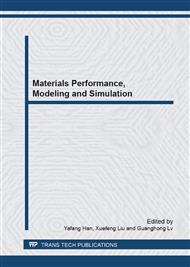[1]
W.A. Soffa, D.E. Laughlin, High-strength age hardening copper-titanium alloys, Prog. Mater Sci. 49(3-4) (2004) 347-366.
DOI: 10.1016/s0079-6425(03)00029-x
Google Scholar
[2]
S. Nagarjuna, M. Srinvivas, K. Balasubraman, D.S. Sarma, On the variation of mechanical properties with solute content in Cu-Ti alloys, Mater. Sci. Eng. A 259(1) (1999) 34-42.
DOI: 10.1016/s0921-5093(98)00882-x
Google Scholar
[3]
A. Datta, W.A. Soffa, Structure and properties of age hardened Cu-Ti alloys, Acta Metall. 24(11) (1976) 987-1001.
DOI: 10.1016/0001-6160(76)90129-2
Google Scholar
[4]
S. Nagararjuna, K. Balasubramanian, D.S. Sarma, Effect of Ti additions on the electrical resistivity of copper, Mater. Sci. Eng., A 225(1-2) (1997) 118-124.
Google Scholar
[5]
S. Suzuki, K. Hirabayashi, H. Shibata, K. Mimura, M. Isshiki, Y. Waseda, Electrical and thermal conductivities in quenched and aged high-purity Cu-Ti alloys, Scripta Mater. 48(4) (2003) 431-435.
DOI: 10.1016/s1359-6462(02)00441-4
Google Scholar
[6]
V. Lebreton, D. Pachoutinski, Y. Bienvenu, An investigation of microstructure and mechanical properties in Cu-Ti-Sn alloy, Mater. Sci. Eng. A 508(1-2) (2009) 83-92.
DOI: 10.1016/j.msea.2009.01.050
Google Scholar
[7]
S. Nagarjuna, D.S. Sarma, Effect of cobalt additions on the age hardening of Cu-4. 5Ti alloy, J. Mater. Sci. 37(10) (2002) 1929-(1940).
Google Scholar
[8]
D. Bozic, O. Dimcic, B.I. Cvijovic, V. Rajkovic, The combination of precipitation and dispersion hardening in powder metallurgy produced Cu-Ti-Si alloy, Mater. Charact. 59(8) (2008) 1122-1126.
DOI: 10.1016/j.matchar.2007.09.005
Google Scholar
[9]
I.S. Batra, A. Laik, G.B. Kale, G.K. Dey, U.D. Kulkarni, Microstructure and properties of a Cu-Ti-Co alloy, Mater. Sci. Eng. A 402(1-2) (2005) 118-125.
DOI: 10.1016/j.msea.2005.04.015
Google Scholar
[10]
R. Markandeya, S. Nagarjuna, D.S. Sarma, Influence of prior cold work on age hardening of Cu-Ti-Zr alloys, Mater. Sci. Technol. 21(10) (2005) 1171-1180.
DOI: 10.1179/174328405x58922
Google Scholar
[11]
V. Lebreton, D. Pachoutinski, Y. Bienvenu, An investigation of microstructure and mechanical properties in Cu-Ti-Sn alloys rich in copper, Mater. Sci. Eng. A 508(1-2) (2009) 83-92.
DOI: 10.1016/j.msea.2009.01.050
Google Scholar
[12]
D.J. Wang, W.F. Zhou, D.F. Wang, Study on aging hardening of new-type aeronautic wear-resisting Cu-Ti-Co alloy, Hot Working Tech. 37(10) (2008) 41-43.
Google Scholar
[13]
R. Markandeya, S. Nagarjuna, D.S. Sarma, Effect of prior cold work on age hardening of Cu-4Ti-1Cr alloy, Mater. Sci. Eng. A 404(1-2) (2005) 305-313.
DOI: 10.1016/j.msea.2005.05.072
Google Scholar
[14]
R. Markandeya, S. Nagarjuna, D.S. Sarma, Precipitation hardening of Cu-Ti-Cr alloys, Mater. Sci. Eng. A 371(1-2) (2004) 291-305.
DOI: 10.1016/j.msea.2003.12.002
Google Scholar
[15]
R. Markandeya, S. Nagarjuna, D.V.V. Satyanarayana, Correlation of structure and flow behaviour of Cu–Ti–Cd alloys, Mater. Charact. 428(4-5) (2006) 233-243.
DOI: 10.1016/j.msea.2006.05.034
Google Scholar
[16]
S. Nagarjuna, M. Srinivas, Grain refinement during high temperature tensile testing of prior cold worked and peak aged Cu-Ti alloys: Evidence of superplasticity, Mater. Sci. Eng. A 498(1-2) (2008) 468-474.
DOI: 10.1016/j.msea.2008.08.029
Google Scholar
[17]
J.Q. Deng, Study on severe plastic deformation processed Cu-Cr-Zr in-situ composites, PhD thesis, East China University of Science and Technology, (2010).
Google Scholar


